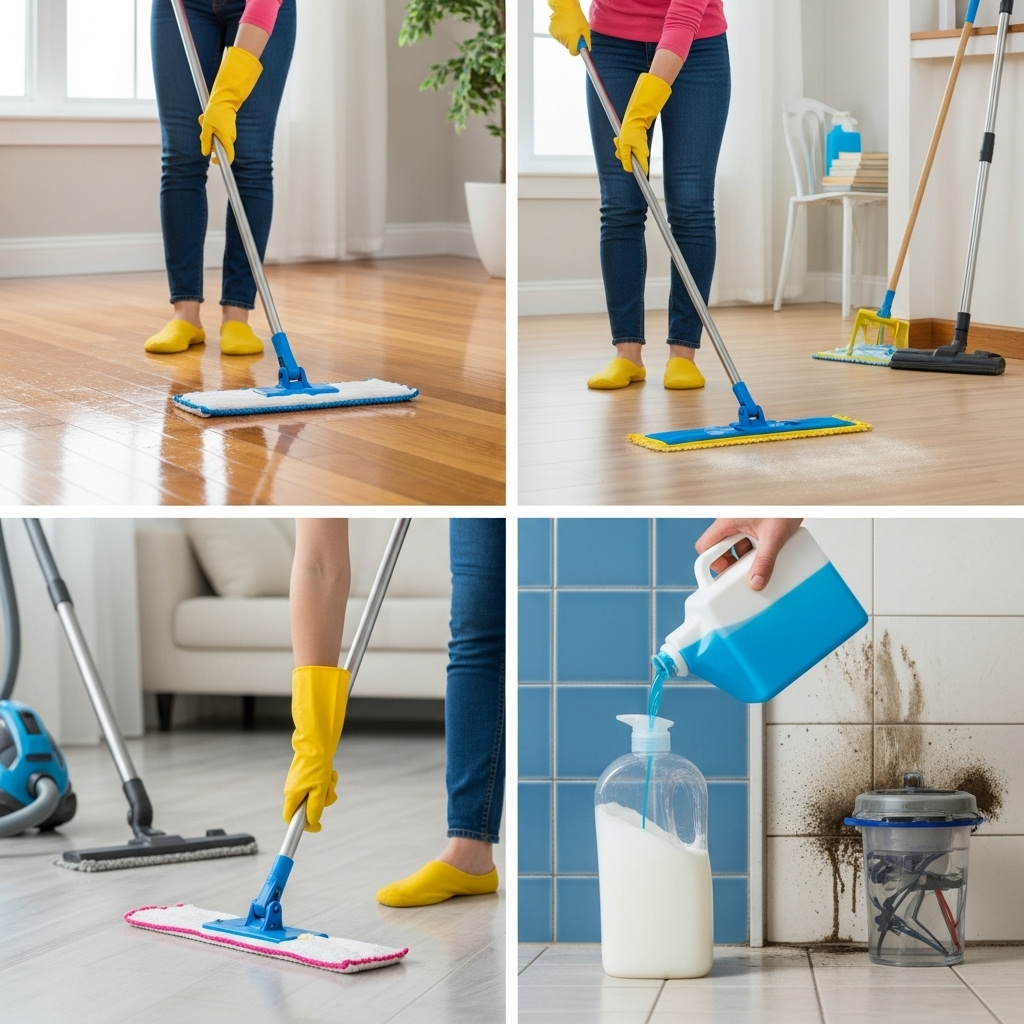Introduction
Keeping your floors clean is more than just a matter of aesthetics—it plays a crucial role in maintaining a healthy, safe, and welcoming home environment. Floors accumulate dust, allergens, pet hair, spills, and germs on a daily basis, which can affect indoor air quality and increase the risk of slips and falls. That’s why investing in the right floor cleaning tools is essential for every homeowner or renter who wants a cleaner, more hygienic space.
Different types of flooring—such as hardwood, tile, vinyl, laminate, and carpet—require unique cleaning approaches. What works well on one surface might damage another, so using the correct tools not only improves cleanliness but also protects your floors and extends their lifespan.
In this comprehensive guide, we explore the top-rated floor cleaning tools available in today’s market. From classic mops and brooms to advanced robot vacuums and electric spin scrubbers, we break down which tools work best for specific floor types and home sizes. Whether you’re doing quick daily maintenance or a deep seasonal clean, these tools are designed to make your life easier and your floors spotless.
You’ll also find expert tips on how to choose the right tools based on your needs, budget, and lifestyle—plus recommendations on the most efficient cleaning techniques. Whether you live in a small city apartment, a suburban home, or a pet-friendly household, this guide will help you clean smarter—not harder.
Let’s discover the best floor cleaning tools that deliver real results—so your floors always look their best.
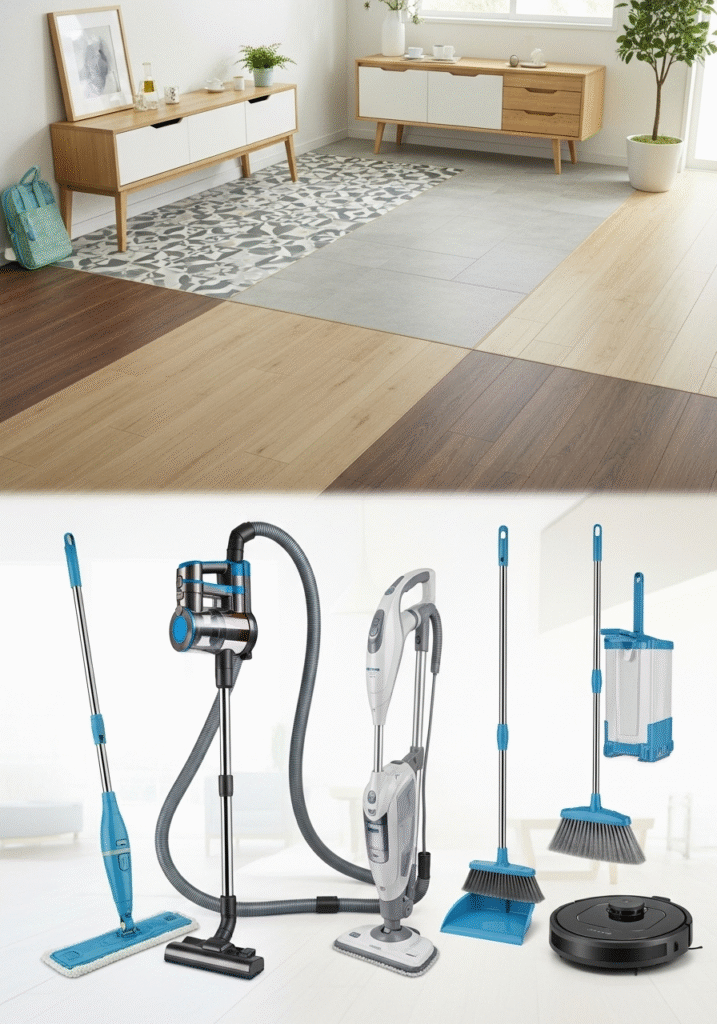
Why Choosing the Right Floor Cleaning Tools Matters
Choosing the right floor cleaning tools is one of the most important decisions you can make for maintaining a healthy and beautiful home. While it might seem like all mops or vacuums are the same, using the wrong tool for your specific flooring type can cause more harm than good. For instance, using an overly wet mop on hardwood can lead to warping or staining, while a low-powered vacuum may struggle to lift pet hair, dust, and allergens from carpet fibers—leaving your floors looking dirty and feeling unclean.
Each flooring surface—whether tile, laminate, vinyl, hardwood, or carpet—requires a specific cleaning approach to protect its finish, maintain hygiene, and ensure long-term durability. The right tools not only get the job done faster, but they also help reduce wear and tear, preventing expensive repairs or premature replacements.
Here are some key reasons why selecting the proper cleaning tools is essential:
- Saves time and energy: Efficient tools allow you to clean more thoroughly with less effort.
- Prevents floor damage: Proper materials and technology ensure your floor’s surface remains unharmed.
- Delivers deeper cleaning: The right tools reach into corners, under furniture, and across various textures.
- Improves indoor air quality: Removing fine dust, pollen, and dander helps reduce respiratory irritants.
- Controls bacteria and allergens: Sanitizing tools eliminate germs and allergens that settle on floors.
By investing in floor cleaning tools suited to your space, flooring type, and lifestyle, you’re not just cleaning—you’re protecting your home’s value and creating a healthier living environment for everyone.
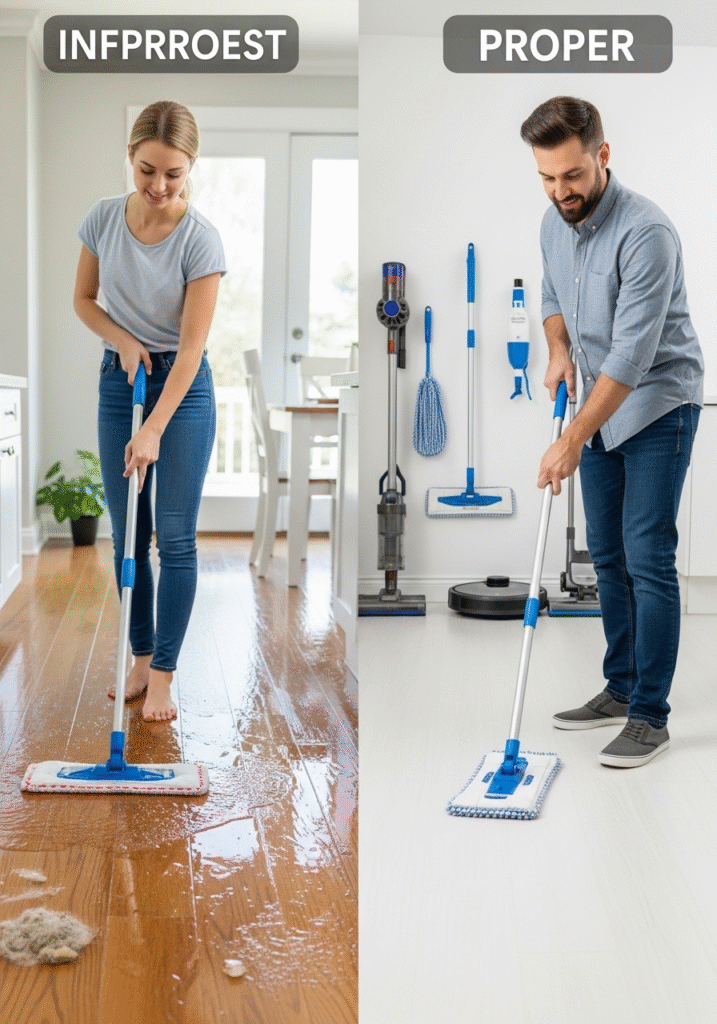
Types of Floor Surfaces and Their Cleaning Needs
Every home features different types of flooring, and each material comes with its own care requirements. Understanding these unique needs is essential when choosing the right floor cleaning tools. The wrong method or product can not only be ineffective—it can also lead to lasting damage. Whether your floors are hardwood, tile, vinyl, laminate, or carpet, tailoring your cleaning strategy ensures longer-lasting beauty, durability, and hygiene.
Hardwood Floors are known for their natural elegance but require gentle maintenance. Excess moisture can seep between planks, causing warping or staining. That’s why microfiber mops and hardwood-specific floor cleaners are recommended. Avoid steam or overly wet mops to protect the wood’s finish.
Tile Floors are more water-resistant but often collect dirt in grout lines. A standard mop might clean the surface, but a scrub brush or electric spin mop is ideal for deep-cleaning grout and textured tiles. A pH-neutral cleaner helps avoid etching the tile glaze.
Laminate Floors may look like wood but are far more sensitive to water. Too much moisture can cause bubbling or separation. A spray mop with minimal dampness or a dry microfiber mop is usually best for these surfaces.
Vinyl Floors are durable and water-resistant, but they can still be scratched by abrasive tools. A soft mop and a gentle vinyl-safe cleaner help maintain the shine without damaging the surface.
Carpets & Rugs trap dirt, dust, and allergens deep in the fibers. A powerful vacuum with HEPA filtration and rotating brushes is essential, especially for homes with pets or children.
By matching your tools to your floor type, you’ll get cleaner results while preserving the integrity and appearance of every surface in your home.
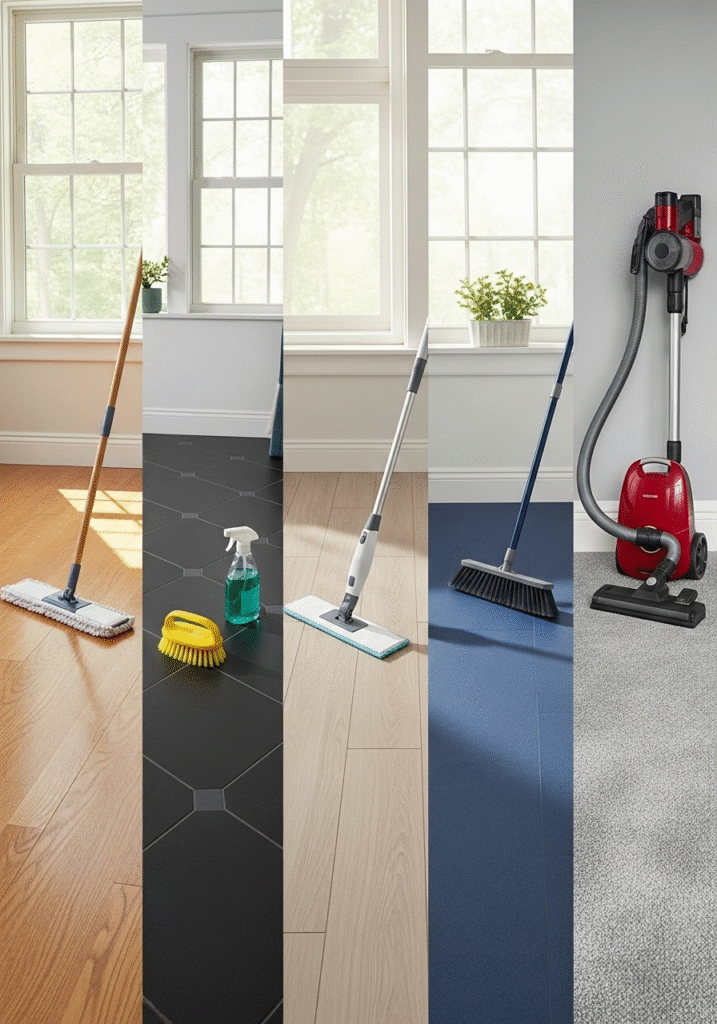
Top 10 Best Floor Cleaning Tools for Home
When it comes to maintaining a clean and healthy home, the right floor cleaning tools can make all the difference. With so many products available today, knowing which tools are worth the investment can save you time, energy, and even protect the integrity of your flooring. From classic options like brooms and mops to high-tech gadgets like robot vacuums, each tool serves a specific purpose—and when used correctly, they can dramatically improve your cleaning routine.
Here, we’ve compiled a list of the top 10 best floor cleaning tools for homes, covering all floor types and cleaning preferences. Whether you’re tackling sticky spills in the kitchen, dust buildup in the living room, or deep-set dirt in bathroom grout, this list has something for everyone.
- Microfiber Mop – A modern essential, it cleans gently and efficiently without harsh chemicals. Perfect for hardwood, laminate, tile, and vinyl.
- Spin Mop with Bucket – Its hands-free wringing system is ideal for deeper cleaning jobs on tiles and vinyl surfaces.
- Steam Mop – This chemical-free option uses heat to sanitize and clean, making it a favorite in pet- and kid-friendly homes.
- Robot Vacuum Cleaner – A smart, automatic solution that vacuums while you relax—great for daily maintenance and hard-to-reach spots.
- Upright Vacuum Cleaner – With powerful suction and attachments, it’s perfect for deep-cleaning carpets and managing pet hair.
- Cordless Stick Vacuum – Lightweight and versatile, this tool is ideal for quick cleanups across multiple floor types.
- Electric Floor Scrubber – A time-saving machine that scrubs tough grime off tiles and grout with ease.
- Dust Mop – An excellent dry-cleaning tool for sweeping fine dust, hair, and allergens, especially for wood floors.
- Spray Mop – Combines spraying and mopping in one, ideal for fast and efficient everyday cleaning.
- Broom and Dustpan Set – Still a staple, this tool is perfect for dry messes in kitchens, porches, and high-traffic areas.
No matter your home size or flooring type, these tools offer a combination of convenience, power, and precision to keep your floors spotless and shining.
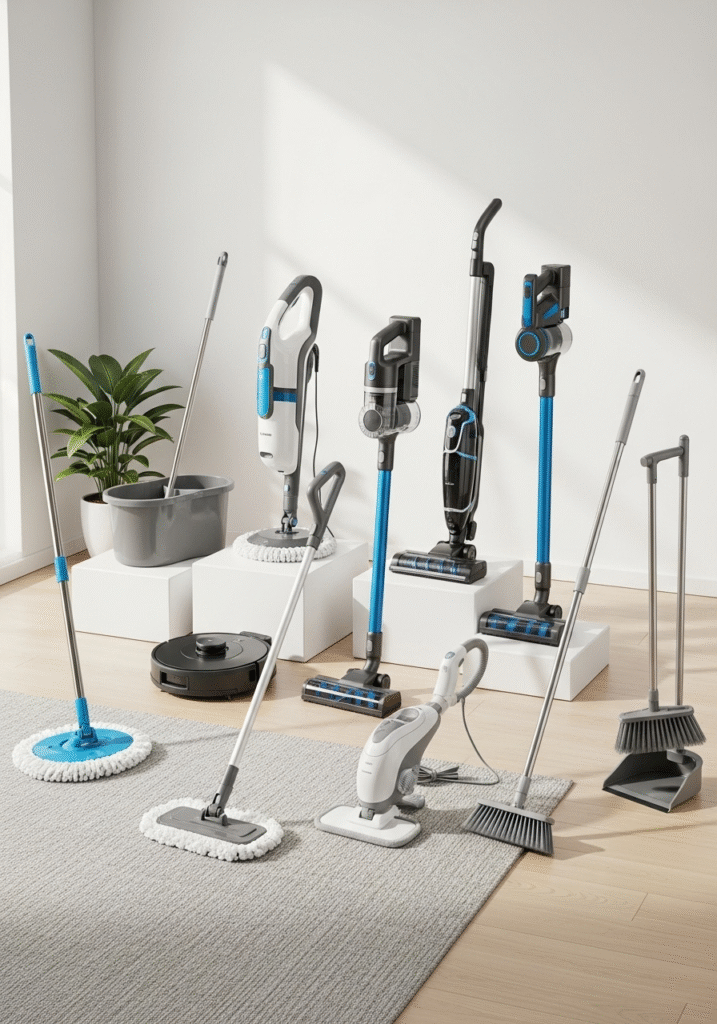
Bonus: Eco-Friendly Floor Cleaning Tools
In today’s world, sustainability is no longer just a trend—it’s a responsibility. As more homeowners strive to reduce their environmental impact, eco-friendly floor cleaning tools are becoming a popular and practical choice. These tools are designed to deliver powerful cleaning results while minimizing waste, harsh chemicals, and energy use. If you’re looking to keep your floors spotless and go green, there are several smart options that help protect your home—and the planet.
One of the easiest ways to start is by switching to reusable mop pads. Unlike disposable pads, these can be washed and reused multiple times, cutting down significantly on single-use plastic waste. Paired with a quality microfiber mop, they offer excellent dust and dirt pickup with minimal environmental cost.
Natural fiber brooms, made from materials like bamboo, coconut husks, or corn fibers, are biodegradable and compostable. They’re just as effective as synthetic versions and break down naturally at the end of their life cycle, making them a great zero-waste option.
Steam cleaners are another eco-friendly alternative. By cleaning and disinfecting using only hot water, they eliminate the need for chemical-based cleaners—making them safe for kids, pets, and allergy sufferers while also reducing indoor pollutants.
For those who enjoy a DIY approach, homemade floor cleaners using ingredients like vinegar, baking soda, lemon, and essential oils can be just as effective as store-bought products. These mixtures are non-toxic, affordable, and safe for most surfaces when used correctly.
By choosing eco-friendly floor cleaning tools, you’re not just making your home cleaner—you’re making a conscious choice to protect your family’s health and the environment. Small changes in your cleaning routine can lead to big benefits for the planet.
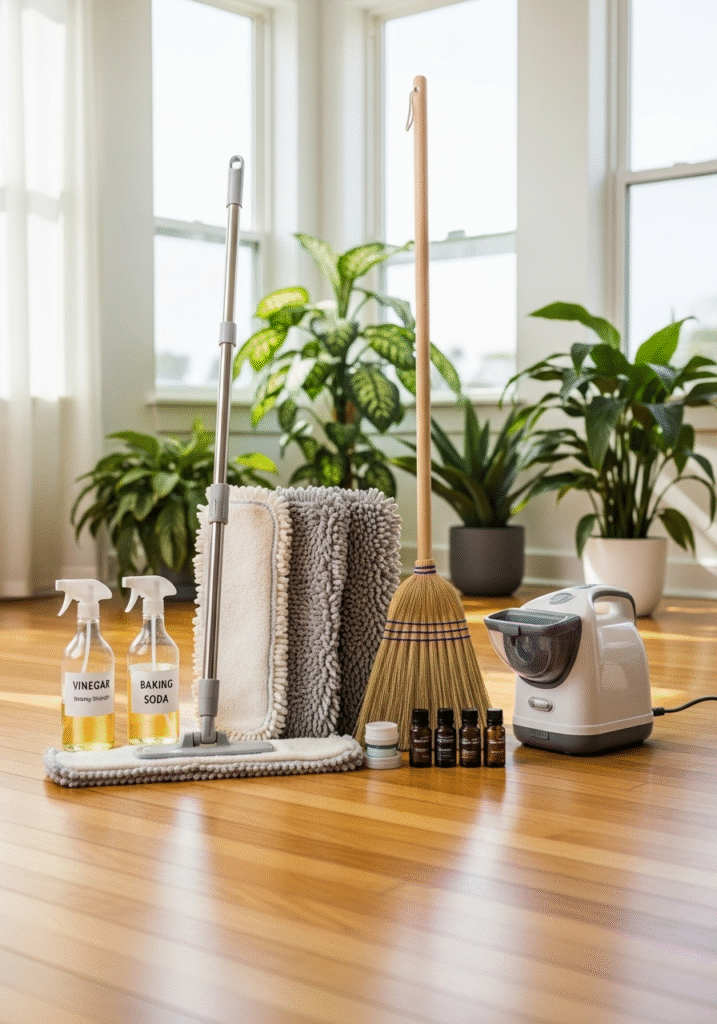
Tips for Maintaining Your Cleaning Tools
Just like your floors need regular cleaning, your cleaning tools also require proper care and maintenance. Dirty or poorly maintained tools can spread germs, reduce cleaning efficiency, and even damage your flooring over time. On the other hand, well-maintained equipment performs better, lasts longer, and ensures your home stays hygienic and spotless. That’s why taking a few minutes to care for your mop, vacuum, and scrubbers can save you time, money, and effort in the long run.
Start with mop heads, which should be washed weekly—especially after heavy use or contact with grease or bathroom surfaces. Reusable microfiber pads can be tossed into the washing machine and air-dried to keep them fresh and effective.
Vacuum cleaners also need regular attention. Always empty the dustbin or replace the bag after each use to maintain suction power. Filters should be cleaned or replaced based on the manufacturer’s guidelines—this not only boosts performance but also improves indoor air quality.
Buckets, brushes, and scrubbers can harbor bacteria and mold if not cleaned properly. It’s a good habit to sanitize these tools at least once a month using a disinfectant or a vinegar-water solution. Make sure all tools are stored in a dry, well-ventilated area to prevent mildew and odor buildup.
Keeping your tools in good shape also means inspecting them regularly for wear and tear. Replace worn-out broom heads, frayed mop fibers, or damaged squeegees to ensure your cleaning remains effective.
Proper maintenance doesn’t take much time but pays off greatly in cleaning results. When your tools are clean, your floors stay cleaner—and your home remains a healthy and welcoming space.
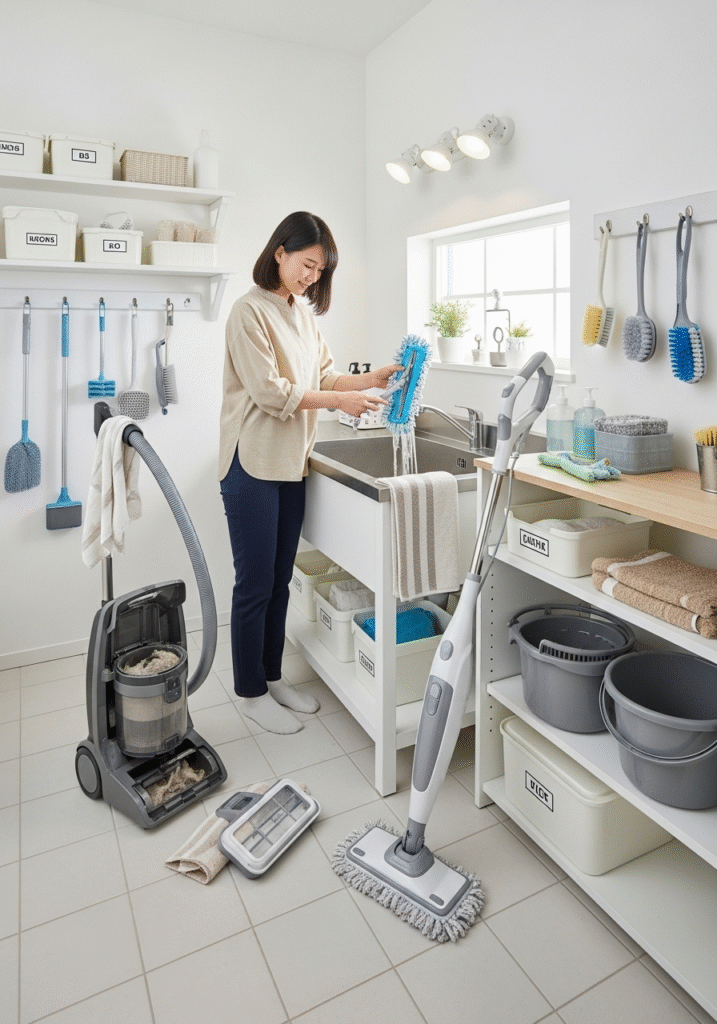
How Often Should You Clean Different Floors?
Keeping your floors clean is essential not only for appearances but also for maintaining a healthy and hygienic home environment. However, not all flooring types require the same cleaning frequency. Understanding the proper schedule for sweeping, mopping, and deep cleaning based on the floor material can help you preserve your floors, reduce allergens, and prevent long-term damage caused by buildup of dirt, moisture, or bacteria.
Here’s a detailed breakdown of how often you should clean each type of flooring:
- Hardwood Floors: Hardwood adds warmth and elegance to your home, but it’s prone to scratches and water damage. Daily sweeping or dry dusting helps remove grit and debris that can harm the finish. Mop once a week using a slightly damp microfiber mop to maintain shine without warping the wood.
- Tile Floors: Tiles are durable and water-resistant, making them ideal for bathrooms and kitchens. However, they still collect dust and grime, especially in grout lines. Sweep every 2 days and mop twice a week with a gentle tile cleaner or steam mop for best results.
- Vinyl and Laminate Floors: These are popular for being low-maintenance, but they still need regular care. Use a microfiber mop or a spray mop once a week with minimal moisture to avoid damage—especially with laminate, which can swell if water seeps into seams.
- Carpets and Rugs: Carpets harbor dust, dander, and allergens deep within their fibers. Vacuum at least twice a week, or more frequently in high-traffic or pet areas. Deep clean monthly using a steam cleaner or carpet shampooer to eliminate bacteria and odors.
- Entryways: These areas trap the most outdoor dirt. Daily sweeping or vacuuming helps contain messes before they spread throughout the house.
Regularly cleaning your floors using the correct frequency keeps your home cleaner, your air fresher, and your flooring materials in excellent condition for years to come.
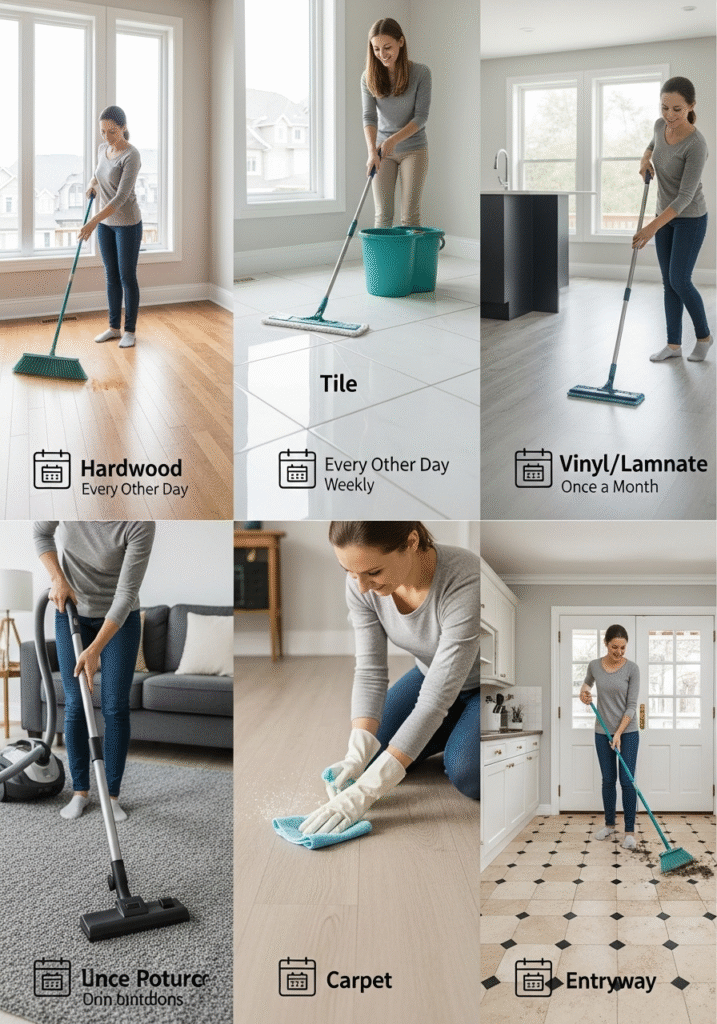
DIY Natural Floor Cleaning Solutions
Want sparkling clean floors without relying on harsh chemicals? You’re not alone. Many homeowners today are turning to natural, homemade floor cleaning solutions that are not only effective but also safer for children, pets, and the environment. DIY cleaners made from ingredients like vinegar, baking soda, lemon juice, and essential oils offer a budget-friendly, non-toxic alternative to commercial products—without sacrificing cleaning power.
Here are a few easy and effective DIY natural cleaning recipes tailored for different floor types:
1. All-Purpose Floor Cleaner
Perfect for tile, vinyl, or laminate flooring, this cleaner removes grime and deodorizes without leaving residue.
- Ingredients:
- 1/2 cup white vinegar
- 1 tablespoon baking soda
- 10 drops essential oil (like lavender or tea tree)
- 1 liter warm water
Mix all ingredients in a bucket. The baking soda cuts through dirt, vinegar disinfects, and essential oils leave a fresh scent. Mop as usual.
2. Wood Floor Polish
Give hardwood floors a nourishing shine with this natural polish.
- Ingredients:
- 1/2 cup olive oil
- 1/4 cup lemon juice
Shake well in a spray bottle, spray lightly on the floor, and mop with a soft microfiber cloth. The olive oil conditions the wood while lemon juice cleans and leaves a natural shine.
3. Tile Grout Scrub
Grout lines can collect stubborn dirt and bacteria. This powerful paste helps lift stains and brighten grout.
- Ingredients:
- Baking soda
- Water
Mix into a thick paste, apply to grout lines, and scrub with an old toothbrush. Rinse with warm water for fresh-looking tiles.
These natural cleaning solutions are simple to make, cost-effective, and environmentally responsible. Best of all, they’re free from harmful fumes, making them ideal for families with babies, pets, or anyone with allergies or chemical sensitivities.
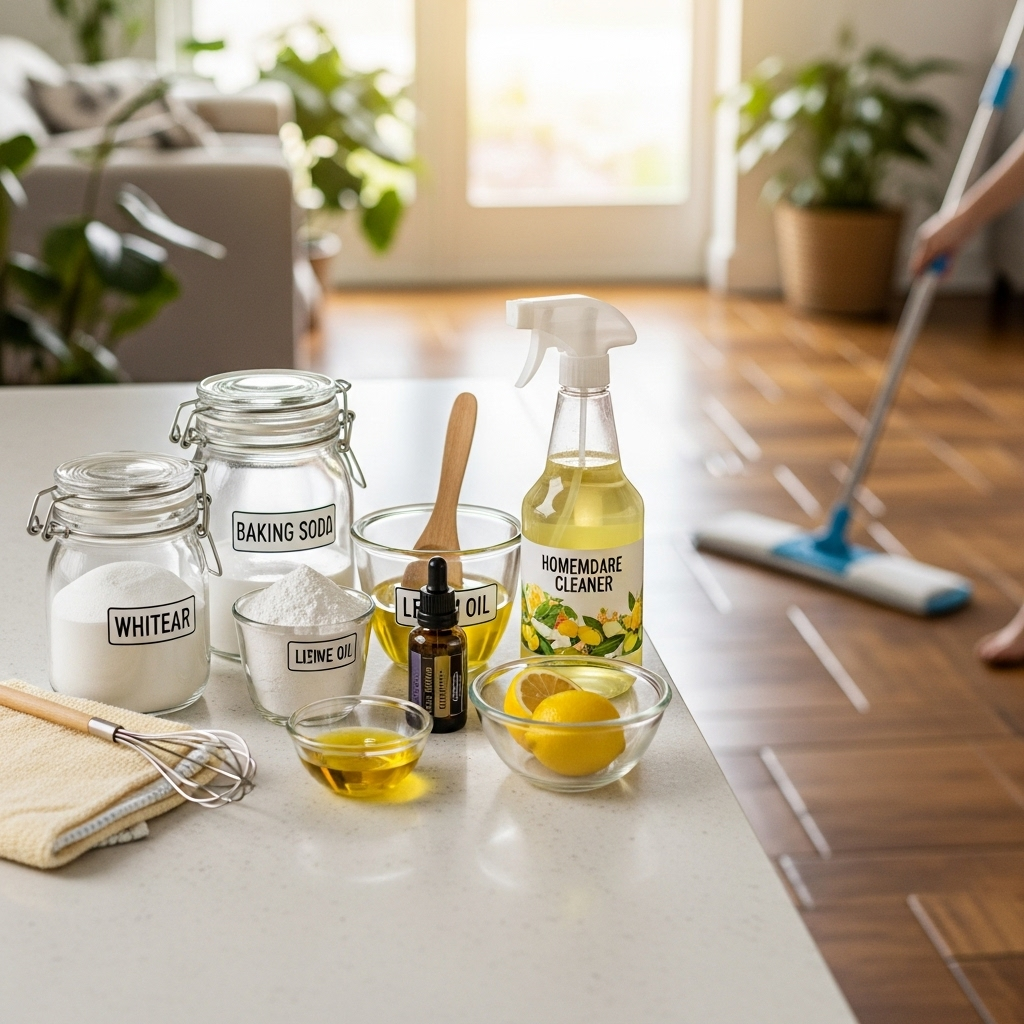
Mistakes to Avoid While Cleaning Floors
Cleaning your floors may seem like a simple task, but even small mistakes can lead to costly damage, reduced cleaning effectiveness, or health hazards over time. Whether you have hardwood, tile, vinyl, or carpet, using the wrong techniques or tools can shorten the lifespan of your flooring and make your efforts less effective. To help you clean smarter and protect your home’s surfaces, here are some of the most common floor cleaning mistakes to avoid—and what to do instead.
1. Using Too Much Water on Hardwood
Water is hardwood’s worst enemy. Excess moisture can seep into seams and cracks, causing the wood to swell, warp, or stain. Always use a slightly damp mop and avoid puddling or dripping water.
2. Not Vacuuming Before Mopping
Mopping a dusty or crumb-covered floor just spreads dirt around. Always vacuum or sweep first to remove loose particles—especially on laminate and tile—before using any wet cleaning method.
3. Skipping Grout Lines on Tile
Tile surfaces may look clean, but dirty grout can harbor mold, mildew, and bacteria. Regularly scrubbing grout lines with a brush or grout-specific cleaner helps maintain hygiene and the appearance of your floors.
4. Using Bleach or Harsh Chemicals on Sensitive Surfaces
Bleach and strong disinfectants can damage natural stone, hardwood, and vinyl surfaces. They may also release toxic fumes. Stick to pH-neutral or floor-specific cleaners, or go for natural alternatives like vinegar-based solutions.
5. Ignoring Tool Maintenance
Dirty mops, clogged vacuums, and worn-out brushes do more harm than good. Wash mop heads, empty vacuum bins, and sanitize scrubbers regularly to keep your tools in top shape.
6. Mixing Cleaning Chemicals
Combining products like bleach and ammonia can create dangerous, even toxic, fumes. Never mix cleaning agents unless the label says it’s safe.
Avoiding these simple yet common mistakes will help you extend your floor’s lifespan, improve cleanliness, and protect your family’s health.
